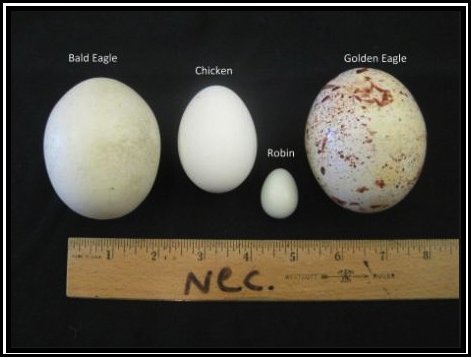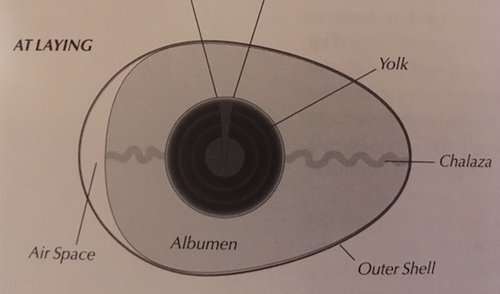Hanover Bald Eagle Blog # 13
In partnership with Pennsylvania Game Commission and Comcast Business .
At approximately 5:07 on Tuesday evening, the moment we’ve been waiting for finally arrived in the form of an oval-like, mostly white, rough-textured, beautiful EAGLE EGG! Congratulations to Liberty and Freedom; we are all eager to see what lies in store for this brand-new addition to the Hanover nest.
The development of Liberty and Freedom’s future eaglet has already begun to occur. There will be approximately 35 days between now and hatching, and a second egg is likely to join the first sometime in the next 2-3 days. The average clutch size for Bald Eagles is 2 eggs, and a full clutch is often completed in 6 days. A Clutch refers to an entire set of eggs laid by one female.

The weight of one eagle egg is about as much as a deck of cards
The interval between each laid egg differs among bird species; as a general rule of thumb, the larger the bird the longer the interval. This is likely because producing the necessary material for a healthy egg takes time, and the larger the egg the more material is required. Most birds lay eggs at intervals of 24 hours, meaning Liberty’s next egg may arrive in the early evening. However, as always, be prepared for exceptions.
Prior to the evolution of hard-shelled eggs with internal membranes, egg-laying animals had no choice but to live near water, where moist environmental conditions were the only place that allowed their embryos to flourish without drying out. Unlike mammalian embryos, bird, reptile and monotreme (echidnas and the platypus) embryos develop independent of their parents, meaning the “egg package” had to evolve fully equipped with protein, carbs, fats, and water.
In his book The Perfect Thing, Tim Birkhead summarizes the incredible feat of evolution that is the bird egg:
“How do you make a structure that keeps microbial aliens out, but at the same time allows the embryo inside to breathe; a shell that is strong enough to withstand the full weight of an incubating parent, but weak enough to allow the chick to eventually break free?”
Most of us are familiar with the structure of a bird egg, though generally this is due to their prevalence in our diet rather than an understanding of how each component facilitates the growth of a baby bird.
Let’s begin with the yolk, where the fat and protein are stored. Yolk size differs with the species. Generally, birds that are born precocial, meaning well-developed and ready-to-go hatch from eggs with a larger yolk (40% of the egg), whereas altricial birds which are born helpless and dependent on their parents, have eggs with a smaller yolk (25%). This makes sense; chicks requiring the most parental care can afford to have access to less stored energy within the egg because they will have more time to develop outside of the egg. This is the case for Bald Eagles.
Eggs also contain albumen, four membranes that provide water and protein to the embryo and serve as a protectant to shelter the developing hatchling from physical damage. However, it is critical that gas exchange from the outside world can make it through this protective layer to reach the embryo. Otherwise the embryo would not receive the necessary oxygen for growth, nor would it be able to dispel carbon dioxide and waste water. Incredibly, egg shells are porous enough to allow this exchange.
Another important part of the egg is the chalazae, which essentially holds the yolk in the center of the egg. These are two stringy structures attaching to the shell on either side of the yolk. Here is what the inside of the egg looks like at time of laying:

Today, on the 1st of March, the heart will begin beating.
I’d like to dedicate this blog to Liberty and Freedom’s first chick, and I encourage us all to reflect today on the sheer beauty and unique innovation of the bird egg. Without it, our world would be a different place, devoid of birdsong, devoid of eagles.
Note:
Earlier this week there was a struggle in the nest as one of the eagles seemed to be caught on some fishing gear that was embedded in a fish. There is no way to ascertain whether the gear’s presence was due to human error, a breakaway fish, or some other cause, however we can all take this event as a reminder to pick up stray fishing gear or other materials that threaten wildlife with entanglement such as balloon strings.
THANK YOU HAWK MOUNTAIN FOR THIS WEEK'S BLOG ENTRY!

RETURN TO HANOVER BALD EAGLE BLOGS
WATCH THE HANOVER BALD EAGLE LIVE CAMS
For over 20 years, HDOnTap has provided live streaming solutions to resorts, amusement parks, wildlife refuges and more. In addition to maintaining a network of over 400 live webcams, HDOnTap specializes in design and installation of remote, off-grid and otherwise challenging live streaming solutions. Contact press@hdontap.com for all media needs, including images and recordings.